As the U.S. stock index futures indicated modest gains on Friday morning, investors are positioned on a tightrope, anxiously waiting for new economic data. The faint upward movement in the futures market—with Dow E-minis climbing 85 points (0.20%), S&P 500 E-minis gaining 16.25 points (0.27%), and Nasdaq 100 E-minis rising 85.25 points (0.40%)—suggests a fragile optimism. However, this sentiment follows a concerning trend that emerged at the start of the new year, with the major indexes suffering declines and reversing early-session gains. This pattern diverges starkly from the typical bullish behavior witnessed in the closing days of December and the initial week of January.
The disheartening performance of major indices, including the S&P 500 and the Dow, poised for weekly losses of over 1%, raises questions about the underlying health of the U.S. economy. Even the technology sector, which has been a beacon of resilience and growth over the past two years, has fallen victim to broader market nervousness. With the Nasdaq showing a drop of nearly 2%, analysts are scrutinizing the potential consequences of the incoming Trump administration’s policies. The uncertainty surrounding proposed changes, especially from the Republican-led Congress, looms large over investor sentiment.
Donald Trump’s administration, set to commence on January 20, has proposed a series of radical policy shifts—lowering corporate taxes, lessening regulatory constraints, instituting tariffs, and implementing stringent immigration controls. While these measures could potentially enhance corporate profitability and invigorate economic growth, they also invite risks such as inflation and complications in monetary policy adjustments. Investors are particularly concerned about how these policy changes will affect interest rates moving forward.
As the yield on the 10-year Treasury note hovers near the psychologically significant 4.5% mark, the financial community watches closely. The CME Group’s FedWatch Tool indicates that traders are bracing for a 50 basis point cut in interest rates this year if the economic data continues to show positive resilience. This expectation reflects the delicate balance policymakers must navigate between stimulating growth and keeping inflation under control.
Earlier in the day, traders will scrutinize the manufacturing activity report from ISM for December, a crucial indicator that could offer insights into the sector’s health as we enter a new year. Anticipation is also building around a forthcoming employment report that is expected to be pivotal in shaping economic narratives. Additionally, remarks from Richmond Fed President Thomas Barkin could provide critical insights regarding the Federal Reserve’s outlook on the economy, especially in a year fraught with uncertainties.
Despite apprehensions regarding inflated equity valuations, many brokerages maintain a bullish outlook on U.S. stocks. Strong corporate earnings, anticipated to emerge throughout the month, may serve as a linchpin to uphold the current bullish cycle that has persisted for over two years. Nonetheless, the upcoming earnings reports will be a litmus test for this prolonged uptrend.
Amidst the broader market noise, specific stocks are experiencing significant fluctuations. Tesla saw a slight rebound of 1.1% in premarket trading following a steep decline of over 6% in the previous session due to disappointing quarterly delivery figures. In contrast, U.S. Steel faced an 8.2% drop after President Joe Biden’s decision to block a significant merger with Nippon Steel, which jeopardizes the company’s future. Block raised 2.8%, spurred by a positive rating upgrade from Raymond James.
As the day unfolds, the focus will shift to U.S. automobile sales data for December, which could yield further insights into consumer confidence and spending behaviors. Given the subdued trading volumes expected post-New Year’s holiday, these developments will be crucial in shaping the trading landscape over the coming days.
While stock index futures edged higher, the underlying currents of economic uncertainty and potential policy changes continue to dominate the narrative. Investors remain vigilant, aware that each scheduled report has the potential to shift market dynamics significantly.

